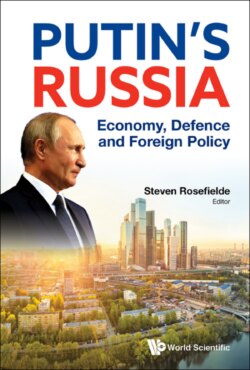Читать книгу Putin's Russia - Группа авторов - Страница 28
На сайте Литреса книга снята с продажи.
Conclusions and Outlook
ОглавлениеGrowth is a key economic indicator in Russia as elsewhere, with direct effects on the leadership’s popularity even if this effect at times is overshadowed by other (often external) events. How to diversify the economy away from oil and boost long-term growth has been the subject of many policy discussion and reform programmes as well as academic studies [see, for example, Kudrin and Gurvich (2015)]. In the academic literature, the focus is often on the role of institutions to create a business environment conducive to sustainable growth and strengthening institutions is an often-heard argument in Russia as well. In particular, improving rule of law, property rights and control of corruption are mentioned.12
It is hard to see why this advice would not be true for Russia, given its current rankings in these areas and the importance of these factors in leading academic studies of institutions and growth (see, e.g., Rodrik et al., 2004 and Barro, 2015). However, it is hard to show that the institutional changes that have taken place in Russia along a number of dimensions including membership in international organisations, EBRD indicators or business rankings have generated growth, investment or trade within the time frames most often used. This is consistent with the finding in Sutyrin and Trofimenko (2017), where the authors look at the effect of formal institutions on FDI flows to Russia and find very little effect from changing institutions.
One reason for the apparent lack of institutional impact on growth is that so much of growth at the macro level is driven by changes in international oil prices, which is not a domestic policy variable, nor linked to institutional developments in Russia. Furthermore, specific policy actions that are not part of an economic development plan create so much uncertainty that it has a greater effect on growth than regular economic policies. In sum, in the short and medium term, it seems that Russian policy actions speak louder than formal institutions when it comes to capital flows and investments, and thus growth.
What does it mean for the Russian outlook? Table 5 summarises Putin’s different terms in office along the dimensions that have been discussed in the previous sections. It is clear that the external factors that facilitate growth in Russia have become increasingly less supportive as we move from the first two terms in office to the third. Instead of the massive increases in oil prices that Putin enjoyed in his two first terms, the third term (and the term as prime minister) saw oil prices falling. This change in fortunes was also reflected in income and investment growth, exchange rates, stock market returns and approval ratings.
The fourth term in office for Putin starts at a time of sanctions and counter-sanctions, volatile oil prices and a general uncertainty in the global economy about trade, financial systems and global growth. As the external environment in general and outlook for oil price increases in particular are less supportive of growth, the priority of the president and his economic team should be on policies and actions that facilitate investments that will generate high growth. This is very much in line with the modernisation and diversification agenda that has been repeated many times in Russia but not been implemented. To make the strategy work this time, the focus should be on a combination of institutional reforms that create a stable business environment and offer incentives for innovative foreign companies to make investments in Russia. Reforms on paper will not be enough but have to be followed up with a consistent path of implementation and avoiding short-run fixes that undermine long-run institutional capital. The previous analysis has shown that policy actions in the past have overshadowed the role of formal institutions and this lesson has to be kept in mind when implementing a new growth strategy. It is therefore crucial that the president refrains from external policies that in the short run detract from economic shortcomings but in the process also generate more uncertainty that is detrimental to capital inflows, investments and growth. The economist’s choice of generating political support through high growth by reforming institutions and avoiding policies that create uncertainty is obvious, but possibly not the most likely choice of Putin in the current domestic and external environment.
Table 5:Putin’s record on growth and its correlates.
Notes: Approval rating, oil price, exchange rate and stock market index are measured at the start of the period. GDP and investments are the levels at the start of the period computed as the sum of the four most recent quarters. FDI inflows and private net capital inflows are the cumulative flows for the duration of the presidential period, where a negative inflow is a net outflow.
